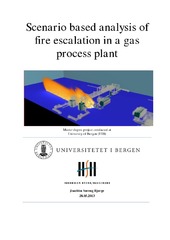| dc.description.abstract | This study takes place on a medium sized gas process plant called reference plant. In this thesis several escalation scenarios, as well as gas dispersion, is evaluated through Kameleon KFX and Vessfire. It has previously been conducted similar escalation studies. However, a normal approach to conduct these studies is to use reference values of a uniform property for heat flux both global and peak, and will only record/evaluate if rupture occurs. In this thesis uses every scenario transient curves for leak flow in KFX to represent the leak (jet fire). From these results individual values for heat flux, both peak and global, is found and used in Vessfire as heat flux exposure on process segment, to evaluate escalation and effect of blowdown. The effect of use of insulation, increased blowdown flow to vent stack and increased wall thickness is also evaluated in this thesis. How a jet fire develops could in some cases be dependent on the geometry of the process site. This is a factor that could get lost when using standardized values for exposure by fire (ref NORSOK S-001). The results indicates that pressurized pipes with the given properties for carbon steel and utilization as used in reference plant (pipes in the range of 2 and 3 inch of diameter) is expected to rupture, when exposed to heat flux over 300 kW/m2 over a time period of 2 to 3 minutes. With the restriction value for flow in the blowdown system today and an increase in flow of 50%, blowdown alone will not prevent rupture of smaller pipe diameters when exposed as described above. However an increase in depressurization flow and a sequential blowdown philosophy, combined with early activation time for initiation of blowdown is proven to minimize the risk of escalation from one process train to another. When a jet fire passes objects the heat flux could increase on the other side as a result of increased turbulence. When a jet fire is directed into larger objects, the location of hot spots (peak flux values) on pipes and nearby equipment will not vary significantly, with time and strength in the release for the chosen scenarios. The values for global and peak flux will actually in some cases be almost constant. Objects can work as flame stabilizers. However, when the jet is unaffected by objects the hot spots could move over larger distances as the release flow decreases. | en_US |
